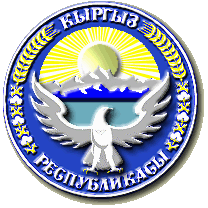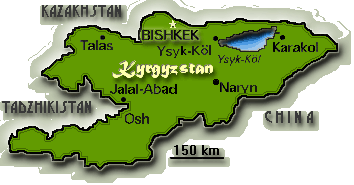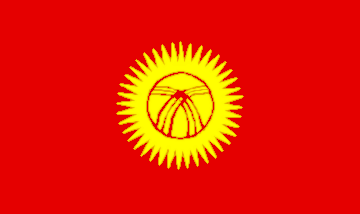Kyrgyzstan


Geography
Location: Central Asia, between China and KazakhstanArea:
total area: 198,500 sq km
land area : 191,300 sq km
comparative area: slightly smaller than South DakotaLand boundaries: total 3,878 km, China 858 km, Kazakhstan 1,051 km, Tajikistan 870 km, Uzbekistan 1,099 km
Coastline: 0 km (landlocked)
Maritime claims: none; landlocked
International disputes: territorial dispute with Tajikistan on southwestern boundary in Isfara Valley area
Climate: dry continental to polar in high Tien Shan; subtropical in southwest (Fergana Valley); temperate in northern foothill zone
Terrain: peaks of Tien Shan rise to 7,000 meters, and associated valleys and basins encompass entire nation
Natural resources: small amounts of coal abundant hydroelectric potential; significant deposits of gold and rare earth metals; locally exploitable coal, oil and natural gas; other deposits of nepheline, mercury, bismuth, lead, and zinc, natural gas, oil, nepheline, rare earth metals, mercury, bismuth, gold, lead, zinc, hydroelectric power
Land use:
arable land: 7%
permanent crops: NEGL%
meadows and pastures: 42%
forest and woodland: 0%
other: 51%Irrigated land: 10,320 sq km (1990)
Environment:
current issues: water pollution; many people get their water directly from contaminated streams and wells and as a result, water-borne diseases are prevalent; increasing soil salinity from faulty irrigation practices
natural hazards: NA
international agreements : NANote: landlocked
People
Population: 4,698,108 (July 1994 est.)
Population growth rate: 1.53% (1994 est.)
Birth rate: 26.33 births/1,000 population (1994 est.)
Death rate: 7.36 deaths/1,000 population (1994 est.)
Net migration rate: -3.64 migrant(s)/1,000 population (1994 est.)
Infant mortality rate: 46.8 deaths/1,000 live births (1994 est.)
Life expectancy at birth:
total population: 67.92 years
male: 63.69 years
female : 72.35 years (1994 est.)Total fertility rate: 3.35 children born/woman (1994 est.)
Nationality:
noun : Kyrgyz(s)
adjective: KyrgyzEthnic divisions: Kirghiz 52.4%, Russian 21.5%, Uzbek 12.9%, Ukrainian 2.5%, German 2.4%, other 8.3%
Religions: Muslim 70%, Russian Orthodox NA%
Languages: Kirghiz (Kyrgyz) - official language, Russian widely used
Literacy: age 9-49 can read and write (1970)
total population: 100%
male: 100%
female: 100%Labor force: 1.836 million
by occupation: agriculture and forestry 38%, industry and construction 21%, other 41% (1990)
Government
Names:
conventional long form : Kyrgyz Republic
conventional short form: Kyrgyzstan
local long form: Kyrgyz Respublikasy
local short form: none
former: Kirghiz Soviet Socialist RepublicDigraph: KG
Type: republic
Capital: Bishkek
Administrative divisions: 6 oblasttar (singular - oblast); Chuy Oblasty, Jalal-Abad Oblasty, Naryn Oblasty, Osh Oblasty, Talas Oblasty, Ysyk-Kol Oblasty
note: the administrative center for Chuy Oblasty is Bishkek; the administrative center for Ysyk-Kol Oblasty may be Ksyk-Kol or Karakol; all other oblasttar have administrative centers of the same name as the oblastIndependence: 31 August 1991 (from Soviet Union)
National holiday: National Day, 2 December; Independence Day, 31 August (1991)
Constitution: adopted 5 May 1993
Legal system: based on civil law system
Suffrage: 18 years of age; universal
Executive branch:
chief of state: President Askar AKAYEV (since 28 October 1990); election last held 12 October 1991 (next to be held NA 1996); results - Askar AKAYEV won in uncontested election with 95% of vote and with 90% of electorate voting; note - president elected by Supreme Soviet 28 October 1990, then by popular vote 12 October 1991; note - AKAYEV won 96% of the vote in a referendum on his status as president on 30 January 1993
head of government: Prime Minister Apas DZHUMAGULOV (since NA December 1993); First Deputy Prime Minister Almambet MATURBRAIMOV (since NA)
cabinet: Cabinet of Ministers; subordinate to the presidentLegislative branch: unicameral
Zhogorku Keneshom: elections last held 25 February 1990 for the Supreme Soviet (next to be held no later than NA November 1994 for the Zhogorku Keneshom); results - Communists 90%; seats - (350 total) Communists 310Judicial branch: Supreme Court
Political parties and leaders: Social Democrats, Ishenbai KADYRBEKOV, chairman; Kyrgyzstan Democratic Movement (KDM), Kazat AKHMATOV, chairman; National Unity, German KUZNETSOV; Communist Party, Dzhumalbek AMANBAYEV, chairman; Erkin (Free) Kyrgyzstan Party, Topchubek TURGUNALIYEV, chairman
Other political or pressure groups: National Unity Democratic Movement; Peasant Party; Council of Free Trade Unions; Union of Entrepreneurs; Agrarian Party
Member of: CIS, CSCE, EBRD, ECE, ECO, ESCAP, IBRD, ICAO, IDA, IDB, IFAD, IFC, ILO, IMF, IOC, NACC, OIC, PCA, UN, UNCTAD, UNESCO, UNIDO, UPU, WHO
Diplomatic representation in US:
chief of mission: (vacant)
chancery: (temporary) Suite 705, 1511 K Street NW, Washington, DC 20005
telephone: (202) 347-3732/3
FAX: (202) 347-3718US diplomatic representation:
chief of mission: Ambassador Edward HURWITZ
embassy : Erkindik Prospekt #66, Bishkek 720002
mailing address: use embassy street address
telephone: 7-3312 22-29-20, 22-26-93, 22-29-89
FAX: 7-3312 22-35-51
Economy
Overview: Kyrgyzstan is one of the smallest and poorest states of the former Soviet Union. Its economy is heavily agricultural, producing cotton and tobacco on irrigated land in the south, grain in the foothills of the north, and sheep and goats on mountain pastures. Its small and obsolescent industrial sector, concentrated around Bishkek, is heavily dependent on Russia and other CIS countries for customers and for inputs, including most of its fuel. Since 1990, the economy has contracted by almost 40%. Kyrgyzstan's inflation was high in 1993, about 23% per month, but rates were declining at the end of the year. Kyrgyzstan introduced its national currency, the som, in May 1993, it has privatized 28% of its former state assets, and plans call for a massive voucher privatization in 1994. Although Kyrgyzstan will receive relatively large flows of foreign aid, ongoing economic restructuring will continue to be painful with an anticipated increase in unemployment as uneconomic enterprises close. President AKAYEV will be under strong political pressure to backtrack on some reform measures.
National product: GDP - purchasing power equivalent - $11.3 billion (1993 estimate from the UN International Comparison Program, as extended to 1991 and published in the World Bank's World Development Report 1993; and as extrapolated to 1993 using official Kirghiz statistics, which are very uncertain because of major economic changes since 1990)
National product real growth rate: -13.4% (1993 est.)
National product per capita: $2,440 (1993 est.)
Inflation rate (consumer prices): 23% per month (1993 est.)
Unemployment rate: 0.2% includes officially registered unemployed; also large numbers of unregistered unemployed and underemployed workers
Budget:
revenues: $NA
expenditures : $NA, including capital expenditures of $NAExports: $100.4 million to countries outside the FSU (1993 est.)
commodities : wool, chemicals, cotton, ferrous and nonferrous metals, shoes, machinery, tobacco
partners: Russia 70%, Ukraine, Uzbekistan, Kazakhstan, and othersImports: $105.8 million from countries outside the FSU (1993 est.)
commodities: grain, lumber, industrial products, ferrous metals, fuel, machinery, textiles, footwear
partners: other CIS republicsExternal debt: $NA
Industrial production: growth rate -27% (1993 est.)
Electricity:
capacity: 4,100,000 kW
production: 11.8 billion kWh
consumption per capita: 2,551 kWh (1992)Industries: small machinery, textiles, food-processing industries, cement, shoes, sawn logs, refrigerators, furniture, electric motors, gold, and rare earth metals
Agriculture: wool, tobacco, cotton, livestock (sheep, goats, cattle), vegetables, meat, grapes, fruits and berries, eggs, milk, potatoes
Illicit drugs: illicit cultivator of cannabis and opium poppy; mostly for CIS consumption; limited government eradication program; used as transshipment point for illicit drugs to Western Europe and North America from Central and Southwest Asia
Economic aid:
recipient: $80 million in 1993 and an anticipated $400 million in 1994Currency: introduced national currency, the som (10 May 1993)
Exchange rates: NA
Fiscal year: calendar year
Communications
Railroads: 370 km; does not include industrial lines (1990)
Highways:
total: 30,300 km
paved and graveled: 22,600 km
unpaved: earth 7,700 km (1990)Pipelines: natural gas 200 km
Ports: none; landlocked
Airports:
total: 52
usable: 27
with permanent-surface runways : 12
with runways over 3,659 m: 1
with runways 2,440-3,659 m : 4
with runways 1,060-2,439 m: 13
note: a C-130 can land on a 1,060-m airstripTelecommunications: poorly developed; 342,000 telephones in 1991 (also about 100,000 unsatisfied applications for household telephones); 76 telephones per 1,000 persons (31 December 1991); microwave radio relay is principal means of intercity telephone links; connections with other CIS countries by landline or microwave and with other countries by leased connections with Moscow international gateway switch and by satellite; 2 satellite earth stations - 1 GORIZONT and 1 INTELSAT (links through Ankara to 200 other countries and receives Turkish broadcasts); broadcast receivers - radios 825,000, TVs 875,000, radio receiver systems with multiple speakers for program diffusion 748,000
Defense Forces
Branches: National Guard, Security Forces (internal and border troops),Civil Defense
Manpower availability: males age 15-49 1,123,959; fit for military service 912,516; reach military age (18) annually 44,528 (1994 est.)
Defense expenditures: $NA, NA% of GDP.
CIA Data Files (1994)
This page was last up-dated:
